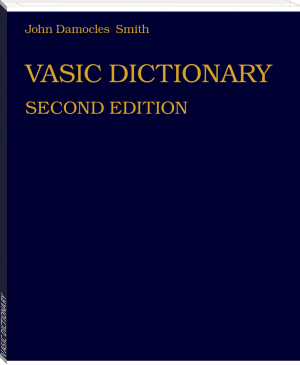VASIC DICTIONARY by John Damocles Smith (polar express read aloud TXT) 📕

Read free book «VASIC DICTIONARY by John Damocles Smith (polar express read aloud TXT) 📕» - read online or download for free at americanlibrarybooks.com
- Author: John Damocles Smith
Read book online «VASIC DICTIONARY by John Damocles Smith (polar express read aloud TXT) 📕». Author - John Damocles Smith
Vasic Dictionary
This dictionary is subject to constant updating and alteration. This is a constant norm in the making of an artificial language (nowadays called a "Conlang" or constructed language). Perhaps the most famous examples of conlangs are Esperanto by L.L. Zamenhof and Tolkien's Elvish for his Lord Of The Rings universe and Klingon in the Star Trek universe.
Please be sure to download the update from time to time.
What is Vasic?
Vasic (pronounced by rhyming it with "Classic" and not "Basic") is a conlang I originally created for a work of fiction I attempted to write in 1989 but never completed. It is set in a fictional nation called "Vasica" and the language of the people, Vasic.
Someday, I hope to revive my world of fiction and use it for that. Even so, Vasic is not the original form of my conlang. I originally tried making a conlang back in 1980 after watching a movie which used a fictional language. I liked the idea and created a Sci-Fi universe and the alien civilization which lives in it and then part of the language they spoke. I repurposed my childhood conlang, modified some of it and called it Vasic.
How does Vasic work as a conlang?
Outside of my fictional world of Vasica, Vasic, in the real world, is a conlang designed mainly for English-speaking people. It is heavily based on English grammar so that one may learn it as if one already knows the grammar of the language to begin with, thus enabling easier and faster learning.
Vasic is easiest to learn by English-speaking people who know how to pronounce Japanese and/or Spanish, Italian, German etc... but not necessary.
The sounds of Vasic is intended to sound like a mixture of Japanese and German (my two favourite languages) with some Chinese-style word endings and the occasional Russian and English sounds.
Advantages:-
-Works like English in almost every way.
-English-based grammatical structure enabling word-for-word translations with very few exceptions.
-Almost all English irregular verbs are rendered regular in Vasic.
-English wordplay and jokes can be translated accurately with very few exceptions.
-English idiomatic expressions can be translated accurately (with very few exceptions) as English is highly idiomatic in nature.
-Phonetic pronunciation.
Changes to the Vasic conlang since the first edition.Changes to the Vasic Conlang.
"INT" = Originally meant three things. "Dad," "Eat" and "Slide." (A mistake that I didn't even notice). I have changed two translations because they would cause complications if two (or all three) of those words were to occur in the same sentence.
New forms:-
Dad = INT (Unaltered because it is an abbreviated form of "Father").
Eat = FRINT (Prefixed it with "FR").
Slide = ĪNT (With a long I).
"KRENJ" = Originally translated as both "All" and "Could."
New forms:-
All = KRĒND
Could =KRENJ (Unaltered)
Couldn't = KRENJJEN (Unaltered)
"RE" = Originally "A shot." Not as in the past tense for "Shoot" but as in a shot from a gun, a shot glass, to take a shot etc...
New forms:-
RE = (To) Shoot. (No change)
REVENG (RE.veng) = Past tense for "Shoot."
REFT = (A) Shot.
Note:- "RE" also means "For" and "Bye" as in the abbreviation of "Goodbye."
Chosen = FRÜЁRVENG (FRÜЁR.veng) Originally FRÜЁR.sen before the second edition. "Chosen" is the past participle form for "Choose" which is the grammatical reason for this change.
Channel = The original word for "Channel" KAIREIN (KAI.REIN) has been changed to KAVTRENJ (KAV.TRENJ) because when I try to pronounce "Conlang channel" (KAIREN KAIREIN) it sounds too awkward.
Boundary = No longer "SWIDNE" it is now JENTVENGYEKYĒ (JENT.veng.ye.kyē)
"Bound" = Bind.
+ -veng (past tense).
+ "-ary"
Taken/Took = No longer ATHSEN (ATH.sen) It is now ATHVENG (ATH.veng)
"Take" = "ATH"
+past tense "-veng."
Pronunciation guide
Vasic Pronunciation Guide
A = Ago
Ā = Long A (As in "Charge" without the "R" sound)
Ǎ = Anglo A (As in "Bat")
à = Mute A as in "Batsman." (Almost like saying "Batsm'n) It is the same as Ǎ except it is almost unpronounced, like a glottal stop. This sound occurs in English in some words with two As in them with the second A almost unpronounced such as in "Scarab" and "Arab." This is not often used in Vasic and is used mainly for transliterating glottal stops and words with mute letters, usually A.
B = Bet
CH = Chin
D = Den
E = Bet
Ē = Long E (As in the "AI" from "Air" without the "R" sound, or as in the first E from "There" without the R sound).
ЁR = Her
F = Fit
G = Get
H = Hill
I = Bit
Ī = Long I (As in Machine)
J = Jet
K = Kit
KW = Same as the "Q" in Quit.
L = Let
M =Met
N = Net
O = Off (As in the Spanish "No.")
Ō = Long O (As in "Chore" but without the "R" sound, or as in the "AW" in the British pronunciation of "Law.")
Ǒ = Of (The often occurring "O" sound characteristic in English which is so different from the European pronunciation of O as in the Spanish "No.")
P = Pet
Q (Written as "KW")
R = Ring
S = Set
SH = Shin
T = Ten
TH = Thing
TĦ/tħ = The
TS = (As in "Cats")
U = Put
Ū = Long U
Ü = Boot (Distinct from "Long U")
V = Vet
W = Wet
X = Fix
Y = Yet
Z = Zen
Ž = As in the "S" from "Pleasure"
How to use the teaching aidsThe script I made for Vasic exists but their phonetic values are yet to be standardized, so, at this stage, I am using romanized Vasic (written with the Roman alphabet). Vasic is properly spelt with capital English letters.
However, as a teaching aid, Vasic uses a mixture of capital and lowercase letters and periods. The capital letters indicate where to put the stress and the periods are there to indicate where to separate the syllables. This is what I call the "Guide script." It is easier to type all the words in only capital letters instead of all three indicators for the guide script. Therefore the guide script is used as a teaching aid and for faster learning and reading. This dictionary spells all the Vasic words in the proper capital letters and the guide script in brackets to indicate pronunciation.
Single syllable words, such as YIAN (meaning "I" and "Me") Are always capitalized. The only exception to this is if it is a prefix or a suffix because some of them are stressed and some are not. This will be indicated with the guide script in brackets.
Words with more than one syllable might be all stressed or all unstressed or a mixture of both. This is useful to know with compound words or long words. For example, KERA (Meaning "You") is stressed on the first syllable and not the second. So, the spelling and guide script would indicate the pronunciation thus: KERA (KE.ra)
The periods do not indicate pronunciation. They are merely used for indicating where to separate the syllables. This can be especially useful when one does not know when to separate vowels or not.
For example, how does one separate the vowels in the word for "Out?" (AIA) Is the first A and IA separated? Is the AI and the second A separated? Or are all three separate syllables?
The pronunciation is indicated thus: AIA (AI.a)
This means that the first AI is pronounced together and the second A alone. Also, notice that the first AI is capitalized, that is where to put the stress. Therefore one pronounces it with the first AI in a raised tone separate from the second A which is pronounced with a relaxed tone.
As for YIAN, it as two vowels together. So, how can one tell whether if they are separated or not? If they were pronounced separately, then the guide script besides the dictionary entry would be written (YI.AN) but because it is not indicated that way, the vowels are pronounced together, just like in the first AI in AIA.
With this knowledge that one now has, one can tell that the Vasic word for "Beautiful" VYERENZE (Vye.REN.ze) is pronounced by separating the syllables VYE, REN and ZE with the stress on REN.
Finally, notice that the first syllable in Vye.REN.ze is unstressed and yet the first letter is capitalized. This is because the first letter is always spelt with a capital letter even in guide script.
Note:- Great care has been taken into properly indicating where to put the stress. Any mistakes that I, or anyone else notices shall be corrected in a future edition.
AA/An = ZEN
A- = ZEN-
Able = YAT
-able/-ful/-ible = -ZE (-ze)
Above = ZENJANG (ZEN.jang)
Abwehr = ABVЁR (AB.vёr)
Achieve = ZENDAIS (ZEN.dais)
Achievement = ZENDAISWON (ZEN.dais.won)
-acy = -ŽEI.YING (-žei.ying)
-acious/-ous = -VUNG (-vung)
Ad-/At- (Atone, admixture, etc...) = ZEN- (The same as "A-").
Add = DARE (DA.re)
Addict = ZENEZ (ZEN.ez)
Adjudicate = ABARANIŽEI (A.ba.ra.ni.žei)
Admit = ZENAINT (ZEN.aint) "Ad-" ZEN- + "-mit" = -AINT (-Aint) Word core as in "Transmit" and "Remit."
Adrenal = KAMESĒIGYA (Kame.sēi.gya)
Adrenaline = KAMESĒIGYAZET (Kame.sēi.gya.zet)
Adventure = RADNENG (Rad.neng)
Affect = ZENAM (ZEN.am)
Affection = ZENAMRANCHO (Zen.am.ran.cho)
Affectionate = ZENAMRANCHOŽEI (Zen.am.ran.cho.žei)
Affix = ĒVIK (Ē.vik)
Afraid = ZENLEZJE (ZEN.lez.je)
Africa = AFFRITSA (AF.fri.tsa)
African = AFFRIREN (AF.fri.ren)
Afro- = AFFRI- (AF.fri-)
Afro (hairstyle) = DALFRO (DAL.fro)
After = EV
Afternoon = EVTRĀNYE (EV.TRĀ.nye) After + Noon
Age = SĀD
-age = -SĀD (-sād)
Agent = KARENGSE (KA.RENG.se)
Ago = ZENAIYAU (ZEN.AI.yau)
Ahead = ZENTSENG (ZEN.TSENG)
Al- = EJ-
-al = -GYA (-gya)
Alchohol = BRAKKA (BRAK.ka)
Alive = ZENZESK (ZEN.zesk)
All = KRĒND (Changed from the original "KRENJ"





Comments (0)